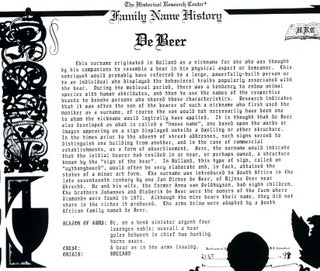
A search on the Google engine exposed multiple data on the De Beer family. Two maistreams occur, namely the Dutch and the British versions.
On the left hind side I scanned the Dutch version. Later on I will refer to the British version.
The Dutch version has the prefix "de" while the British version only refers to "beer".
As for the Dutch version, researhers on the De Beer family traced back our roots to Utrecht in Holland. Other researchers speculate that the De Beers also split up into Switzerland where the city of Bern (German for bear) was found. For this reason, I also scanned old city maps of Bern (De Bern) with the crest of the bear clearly painted in red. This image of the bear perpetuated specifically in my own family line, however, there are other versions on Google of the De Beer crest. I also found German inscriptions on the tomb stones of my great great grand father's grave near Petrusburg in the Free State (South Africa) on the farm
Inhoek. Subsequently I also scanned photographs of the tomb stones in for interesting sake. The family name "Barent Petrus De Beer" is spelt with the German
umlaut. This Barent Petrus came from Graaf Reinette in the Great Karoo while his decendants were from
Prince Albert, a little town towards the South next to the majestic Swart Berg mountain range. Here the De Beer's originally established
Queekvalleij. Zacharias de Beer started this farm in 1762. In 1842 the Dutch Reformed Church, one of the biggest church denominations in South Africa, established a church in
Queekvalleij, but in 1845, the village was named after
Prince Albert, a consort of Queen Victoria. Today, only the neglected graves of the De Beers remain as historical evidence, while the rest of
Prince Albert became an exceptionally beautiful eco tourist attraction (cf.
www.princealbert.org.za for more information).
Fortunately, exciting De Beer historical references are to be found in the Fransie Pienaar museum at Prince Albert. With recognition to this museum's brochure on the history of the De Beers, the following information summarises the roots back to Stellenbosch and Cape Town, South Africa, where the very first De Beers settled after their emigration from Europe.

